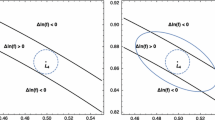Abstract
The paper concerns the dynamics-related properties of the rotation map of a circle (rotation of the plane). A self-similar structure of orbits of the rotation map is established. That is, a possibility of decomposition of orbits of a given rotation map into a finite set of orbits of other such maps is proved—it is shown that every orbit of iterates of the rotation of circle on irrational angle, after linear re-scaling of its argument can be represented as a finite set of such orbits situated on another circles. A pointwise self-similarity of classical trigonometric system is established and an application to Fourier expansion, which emphasizes a possibility of shifting of signals with respect to time, is presented. The free mechanical motion is also considered. A special dynamical spectrum of frequencies or speeds, associated with a given uniform circular or rectilinear motion, is defined. We prove that an appropriate fragmentation of time axis yields a decomposition of a given orbit of the free continuous-time motion into a set of such orbits propagating in new time and such decomposition is consistent with the decomposition of the per time unit discrete motion. Particularly, our theorems assert that due to a piecewise-linear transform of spatial and time variables the rectilinear rays change their direction.
Similar content being viewed by others
References
Arnold V.I.: Mathematical Methods of Classical Mechanics. Nauka, Moscow (1989)
Aubri S.: The twist map, extended Frenkel-Kontorova model and the devil’s staircase. Physica 7D 103, 240–258 (1983)
Bateman, H., Erdelyi, A.: Higher Transcendental Functions, vol. 1. McGraw-Hill, New York (1953)
Billingsley P.: Ergodic Theory and Information. Wiley, London (1965)
Choquet G.: L’Enseignement de la Geometrie. Hermann, Paris (1964)
Ellis R.S.: Gravitational lensing: a unique probe of dark matter and dark energy. Philos. Trans. R. Soc. A 368, 967–987 (2010)
El Naschie M.S.: Time symmetry breaking, duality and Cantorian space–time. Chaos Solitons Fractals 7, 499–518 (1996)
Hermann M.R.: Sur la conjugation differentiable des diffeomorphismes du circle a des rotation. Publ. Math. Inst. Hautes Etud. Sci. 49, 5–233 (1979)
Hilbert D.: The Foundations of Geometry. Court Publishing, Chicago (1902)
Infeld E., Rowlands G.: Nonlinear Waves, Solitons and Chaos. Cambridge University Press, Cambridge (2000)
Kadanoff L.: Scaling for critical KAM trajectory. Phys. Rev. Lett. 47, 1641 (1981)
Kadanoff L., Shenker S.J.: Critical behaviour of a KAM trajectory: I. Empirical results. J. Stat. Phys. 27, 631 (1982)
Khinchin A.Ya.: Three Pearls of Number Theory. Dover, New York (1998)
Kuipers L., Niederreiter H.: Uniform Distribution of Sequences. Wiley, London (1976)
Landau L.D., Lifschitz E.M.: Hydrodynamics. Nauka, Moscow (1988)
Mandelbrot B.B.: The Fractal Geometry of Nature. San Francisco, Freeman (1977)
McKay R.S.: A renormalization group approach to invariant circles in area-preserving maps. Physica 7, 283 (1983)
Miwa T., Jimbo M., Date E.: Solitons: Differential Equations, Symmetries and Infinite Dimensional Algebras. Cambridge University Press, Cambridge (2000)
Nottale, L.: The theory of scale-relativity: non-differentiable geometry and fractal space–time. In: Dubois, D.M. (ed.) Computing Anticipatory Systems, CASYS’03—Sixth International Conference, (Belgium, 2003). AIP Conference Proceedings, vol. 718, pp. 68–95 (2004)
Paladin, G., Vulpiani, A.: Fractal models of 2- and 3-dimensional turbulence. In: Pietroniero, L., Tosatti, E. (eds.) Fractals in Physics. Proc. VI-th Trieste International Symposium on Fractals in Physics. (ICTP, 1985) (1985)
Shahverdian A.Yu.: Boundary behavior of a billiard trajectory in n-dimensional cube. Russ. Math. Surv. 47, 200–202 (1992)
Shahverdian A.Yu.: A finite-difference method for analyzing one-dimensional nonlinear systems. Fractals 8, 49–65 (2001)
Shahverdian A.Yu.: A decomposition of quasi-oscillators. Asian Eur. J. Math. 2, 681–705 (2009)
Weyl H.: The Theory of Groups and Quantum Mechanics. Dover, New York (1931)
Yoccoz, J.-C.: Geometric Dynamics. Lect. Notes Math., 1007 (1983)
Author information
Authors and Affiliations
Corresponding author
Rights and permissions
About this article
Cite this article
Shahverdian, A.Y. A Decomposition of the Rotation of Circle. Results. Math. 61, 143–177 (2012). https://doi.org/10.1007/s00025-010-0082-9
Received:
Revised:
Accepted:
Published:
Issue Date:
DOI: https://doi.org/10.1007/s00025-010-0082-9




